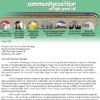A race to spend the money, not to build a High-Speed Rail System.
The latest news is other than the remaining federal funds, the primary source of “continuous revenue” was to come from cap-and-trade auction proceeds. The Authority was warned of the many dangers of relying on these funds and those fears have come home to roost.
It seems the latest auction netted the Rail Authority $2.5 million instead of $150 million. According to the business plan, the cap-and-trade funds were considered the back-up plan for the unreachable Prop 1A funds but there was no back-up plan if the cap-and-trade funds became erratic or disappeared entirely.
According to an LA Times article, referencing State Dept. of Finance spokesperson, H.D. Palmer: ” Palmer noted that there is a $500-million reserve set up in anticipation of volatility that could help close the gap. The use of that reserve will have to be agreed upon by Gov. Jerry Brown and the Legislature.”
It is unknown if this trend of lower auction proceeds will continue. Some think it has to do with the real possibility that the entire cap-and-trade program is in danger of being overturned based on questions the appellate court asked in a suit on appeal that challenges the validity of the program. Please see Third Appellate District Morning Star Packing Company case. With this danger in the air as well as the volatility of the auction proceeds, it would seem the Authority has little chance to sell the cap-and-trade revenue stream thought to breathe some last life into the bullet train financing.
KPCC AirTalk conducted a 12 minute audio interview with political journalist Dan Walters and also Ross Brown, from the LAO, on the Cap and Trade auction failure. You can listen at: “What underwhelming results in state cap-and-trade auction could mean for high-speed rail, other state programs”
Four Year Extension: What does this mean?
Recently the Authority received a four-year extension on the time they have to match federal fund spending per a brand new funding agreement.
Certainly Congressman Jeff Denham has an opinion about the newest changes in his newly released statement:
“The hard-working American taxpayer has a right to know where their money is being spent and the Administration has failed to provide oversight of a flawed project. Congressional hearings will be coming soon.”
But here’s some background about this new agreement not apparent at first glance. Everyone following the project knows that the Authority wasn’t going to make 2018 or in fact even a 2022 deadline, no news there. So what’s the big deal? The impact is the Authority now has more time to fulfill federal matching requirements. Without cap-and-trade dollars they have nothing to match federal spending. Their hope is to find other federal funds, get private investment or get their hands on state bond funds that are currently frozen due to non-compliance of Prop 1A requirements. The Prop 1A law requires completion of all environmental clearances and a finite source of funds to build the segment they are applying for. This is not possible for any segment at this time.
First hints of this time extension request showed up in the December funding year-end report, which the Rail Authority fought tooth and nail not to release which was a clear violation of the Public Records Act. After confronting the Authority of evidence that this particular report had been sent to the FRA, they released the document. Here’s what it said:
“The Authority is requesting a one-year extension to the period of performance and Federal Funding period of the FY10 Grant as a contingency to allow for potential use for testing and demonstration of high-speed service and/or integration with an Initial Operating Segment. The extension period will be from December 31, 2018 to December 31, 2019.”
They also indicated it did not effect the spending deadlines of the ARRA funds which is September 30, 2017.
I wondered what this meant. An Authority representative explained to me in an email. “We are requesting a time-only extension for the period of performance of activities required under the ARRA grant [American Reconstruction and Recovery Act] from September 2017 to December 2019, which does not impact the federal statutory requirement to spend ARRA funds by September 30, 2017.”
So now we see not only did the FRA agree to the Authority’s request, they gave them an extended time frame until 2022, not the 2019 they asked for.
See LA Times writer Ralph Vartabedian’s article on the Authority’s newest grant agreement and how much they will have to spend in order to make the deadline.
Capital Advances:
The Authority received another gift, the Authority told the Department of Transportation (DOT), the parent agency over the Federal Railroad Administration (FRA) it is having cash flow problems and apparently they will be advanced capital in order to acquire right of way. They may advance them as much as 3 months of working capital per DOT Mendez letter noted on page 3.
But in reality it appears to be a shell game on the part of the Authority. They need to spend money in other places first in order to advance the project. They’ve been promising money left and right to other sources such as up to $500 million for stations, $600 million for Caltrain’s electrification project and $500 million for transportation projects in Southern California. Much of this money was to come from Prop 1A money and cap-and-trade was the only backup. It is designated as such under the risk section in the Authority’s newest business plan and now even that plan is in danger if low auction proceeds continue.
Sources of Capital:
The Authority has two sources of money, fed money and cap-and-trade auction dollars estimated at around $500 million per year. They can’t access Prop 1A funds. The ARRA fed grants and the state’s matching funds can only be spent in one place, the Central Valley. The cap-and-trade money has a lot more flexibility. When the Authority received the 25% allocation of the cap-and-trade auctions, the Authority was heading toward Southern California so lawmakers expected the funds to be spent in that direction. Since then the Initial Operating Segment has done an about face and is heading toward San Jose now. It is unclear if the lawmakers from Southern California will protest, the Democrat’s President Pro Tem, seemed OK with the Authority’s promise to spend up to $4 billion dollars in Southern California.
The Authority has one more grant called FY 10 funding and amounts to $928 million. This money must be spent by December 2019 and has a 30% matching requirement. They don’t want to spend those funds until after the ARRA funds are spent, which according to the Mendez letter actually have to be invoiced by June 30, 2017 not the later date of September 30, 2017.
Therefore this new agreement, suspending the requirement to match federal fund spending until after 2017 in the Central Valley is certainly a huge gift since it allows the Authority to use cap-and-trade money elsewhere, that is if they have any.
Express Train to Parsons Brinckerhoff:
There is more to this story. Let’s look at how we went from absolutely no advance spending for federal grant funds to what’s now called the taper match. That is, allowing an imbalance of federal contribution vs. state contributions. A very eloquent way to say there could be more fed funds expended than state funds transferring the primary risk to the federal government.
Here’s an excerpt from an article I wrote years ago:
Roy Kientz, Undersecretary of Policy, Department of Transportation (DOT), sent a letter to the rail authority on May 25, 2011 with a rather unequivocal opinion on the subject of spending fed funds first.
Kientz wrote in that letter, “On the matter of using federal funds up front to postpone use of the State’s matching funds, we hope you will understand why this is not feasible. Both the fiscal year 2010 appropriations law and the FRA grant commitments require matching funds as a prerequisite for this project to go forward. California was awarded funding based in part on the impressive state match promised in the grant applications. Withholding these matching funds would put the California’s high-speed rail project in serious jeopardy.”
However when the Authority got in a jam and didn’t have the cash to match the grant due to the lack of Prop 1A funds, miraculously the wording changed in the Funding Agreement with some fancy rewording of agreements, which allowed them to receive advance funds per a process named the taper match. Supposedly per the General Accounting Office, the FRA has the Authority to overrule the Department of Transportation (DOT) even though the FRA reports to the DOT.
By the way, there is doubt that the HSR service will ever operate in our lifetime but one thing is working and that’s an express service running from federal agencies to Parsons Brinckerhoff (PB), the Authority’s primary contractor. There have been at least three government employees employed by PB after they left their respective agencies. All three had a prominent role with California’s High-Speed Rail Project.
Roy Kientz, Mass Transit Magazine: “Klienitz joins Parsons-Brinckerhoff”
John Porcari, Mass Transit Magazine: “DC John Porcari joins Parsons-Brinckerhoff”
Karen Hedlund, lead attorney who fought for the Authority’s project, Toll Road News: “Hedlund joins Parsons-Brinckerhoff”
It seems like if you’re nice to the project, the project will be nice to you.
The General Accounting office in DC had something to say about the idea of this tapered match found in the agreement on December 18, 2015: “Issues Arising under FRA’s Implementation of California High-Speed Rail Authority Grant Tapered Match Provision”. In part they say, “The grant reflects risk to the federal government because funding for the Authority’s matching share is uncertain, due to financial and legal challenges, and the tapered match increases this risk because it allows federal funds to be spent first. FRA has responsibilities under federal laws, regulations and policies to mitigate these risks.”
So all US Taxpayers are in danger of having their tax funds squandered and they won’t get a thing out of the deal. In fact the Authority’s high-speed rail authority was granted the dishonor of the Golden Fleece Award. The article provides a wonderful summary of the path traveled by the Authority and the disservice it does to all US Taxpayers.




